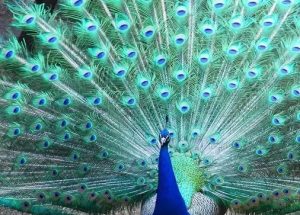
Blue peacocks, with their stunning iridescent plumage and graceful demeanor, are some of the most captivating creatures in the animal kingdom. These magnificent birds have long captured the imagination of people worldwide with their vibrant blue hues and elaborate courtship displays.
In this article, we will delve into the enchanting world of blue peacocks, exploring their physical characteristics, behavior, habitat, and conservation efforts. Join us on this journey as we unravel the secrets behind the allure of these majestic avian wonders.
The Origins of Blue Peacocks
Blue peacocks, scientifically known as Pavo cristatus, are native to South Asia, particularly India and Sri Lanka. They belong to the family Phasianidae, which includes pheasants, quails, and turkeys. These elegant birds have a rich history and have been admired for centuries, both for their beauty and symbolism.
Physical Characteristics
Blue peacocks are large birds, with males reaching an average length of 4 to 7 feet, including their train feathers. They weigh between 9 and 13 pounds. Females, known as peahens, are smaller and less flamboyantly colored. The most striking feature of male blue peacocks is their train, which consists of long, iridescent feathers that can reach up to 5 feet in length. The train feathers have a distinctive eye-like pattern and are mainly responsible for their mesmerizing displays.
Vivid Plumage and Coloration
The vivid blue coloration of male peacocks is a result of structural coloration rather than pigmentation. Microscopic structures within the feathers scatter incoming light, creating an optical phenomenon known as iridescence. Depending on the angle of light and viewing, the feathers can display various shades of blue, turquoise, and green. This visual spectacle is truly a testament to the wonders of nature’s engineering.
Courtship Displays: Nature’s Extravaganza
During the mating season, male blue peacocks put on an extraordinary display to attract potential mates. They fan out their stunning train feathers, forming a vibrant and awe-inspiring circular fan. With rhythmic movements, they quiver their feathers, producing a rustling sound that adds to the spectacle. This extravagant courtship dance is an expression of their vitality, strength, and genetic fitness, captivating both peahens and human onlookers.
Peacock Behavior and Social Structure
Blue peacocks are generally social birds, forming loose flocks outside the breeding season. They are diurnal creatures, spending their days foraging for food, which mainly consists of seeds, insects, small reptiles, and plants. Peafowl are known to roost in trees at night, seeking safety from predators.
The Peacock’s Habitat
Blue peacocks are primarily found in the forests and woodlands of South Asia. They prefer areas with dense vegetation, providing them with both shelter and ample food sources. These birds have also adapted well to human-modified landscapes, including parks, gardens, and agricultural fields.
Threats to Blue Peacocks
Despite their mesmerizing beauty, blue peacocks face several threats in the wild. Habitat loss due to deforestation, poaching for their feathers, and illegal pet trade are some of the significant challenges they encounter. Additionally, they are susceptible to predation by large cats, such as tigers and leopards.
Conservation Efforts
Recognizing the importance of conserving these magnificent birds, numerous initiatives and organizations are working tirelessly to protect blue peacocks and their habitats. Conservation efforts focus on habitat preservation, anti-poaching measures, and raising awareness among local communities about the value of these birds. It is crucial to ensure their long-term survival and maintain the delicate balance of ecosystems they inhabit.
The Significance of Blue Peacocks in Culture and Art
Blue peacocks have fascinated humans for centuries and have found their place in various cultures and art forms. In many ancient civilizations, including India, they were considered symbols of royalty, beauty, and immortality. Their majestic appearance has inspired artists, writers, and designers throughout history, with their motifs often adorning textiles, pottery, and jewelry.
10. Frequently Asked Questions (FAQs)
Q1: Are blue peacocks the only type of peacocks?
No, blue peacocks are the most well-known and widespread species. There are also green peacocks (Pavo muticus) and the critically endangered Congo peafowl (Afropavo congensis).
Q2: Can blue peacocks fly?
Yes, despite their large size and elaborate feathers, blue peacocks are capable of flight. However, they prefer to spend most of their time on the ground.
Q3: How long do blue peacocks live?
In the wild, blue peacocks have an average lifespan of 15 to 20 years. In captivity, they can live up to 25 years or more.
Q4: Why do male peacocks display their feathers?
Male peacocks display their feathers to attract females during courtship. The elaborate train and its vibrant colors serve as visual signals of their genetic fitness and ability to provide for offspring.
Q5: Are blue peacocks endangered?
Blue peacocks are currently not considered endangered. However, their populations have declined in some regions due to habitat loss and poaching, highlighting the need for conservation efforts.
Conclusion
In conclusion, blue peacocks are truly nature’s jewels, captivating us with their iridescent beauty and captivating courtship displays. These remarkable birds have a rich history and cultural significance, symbolizing royalty and immortality.
As they face various threats in the wild, it is essential for us to appreciate and conserve their habitats, ensuring the survival of these majestic creatures for generations to come. Let us cherish the allure of blue peacocks and strive to protect the magnificence they bring to our world.